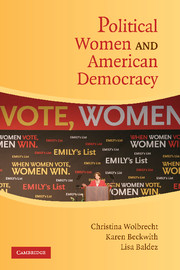Book contents
- Frontmatter
- Contents
- Preface
- List of Contributors
- Political Women and American Democracy
- 1 Introduction: What We Saw at the Revolution: Women in American Politics and Political Science
- 2 Gender as a Category of Analysis in American Political Development
- 3 Gender, Public Opinion, and Political Reasoning
- 4 Gender in the Aggregate, Gender in the Individual, Gender and Political Action
- 5 What Revolution? Incorporating Intersectionality in Women and Politics
- 6 Women's Movements and Women in Movements: Influencing American Democracy from the “Outside”?
- 7 Representation by Gender and Parties
- 8 Women as Candidates in American Politics: The Continuing Impact of Sex and Gender
- 9 Women as Officeholders: Linking Descriptive and Substantive Representation
- 10 Theorizing Women's Representation in the United States
- 11 Political Women in Comparative Democracies: A Primer for Americanists
- 12 Conclusion: Between Participation and Representation: Political Women and Democracy in the United States
- References
- Index
7 - Representation by Gender and Parties
Published online by Cambridge University Press: 05 September 2012
- Frontmatter
- Contents
- Preface
- List of Contributors
- Political Women and American Democracy
- 1 Introduction: What We Saw at the Revolution: Women in American Politics and Political Science
- 2 Gender as a Category of Analysis in American Political Development
- 3 Gender, Public Opinion, and Political Reasoning
- 4 Gender in the Aggregate, Gender in the Individual, Gender and Political Action
- 5 What Revolution? Incorporating Intersectionality in Women and Politics
- 6 Women's Movements and Women in Movements: Influencing American Democracy from the “Outside”?
- 7 Representation by Gender and Parties
- 8 Women as Candidates in American Politics: The Continuing Impact of Sex and Gender
- 9 Women as Officeholders: Linking Descriptive and Substantive Representation
- 10 Theorizing Women's Representation in the United States
- 11 Political Women in Comparative Democracies: A Primer for Americanists
- 12 Conclusion: Between Participation and Representation: Political Women and Democracy in the United States
- References
- Index
Summary
Modern democracy is arguably unthinkable save political parties (Schatt schneider 1942). What about democracy for women? Does democracy for women depend on political parties? At first glance, the answer might appear to be no. Women's representation is potentially at odds with representation by parties. The U.S. party system has often been unwelcoming and unresponsive to women. The two major parties were a barrier to women's suffrage. Indeed, after suffrage was won, the leading women's suffrage organization chose to become a nonpartisan organization. The modern women's movement, which emerged decades later, initially eschewed the political parties. Yet because parties organize government and field candidates for office, the political representation of women in American politics is likely to necessitate representation by parties.
One form of women's political representation is descriptive representation, or the presence of women in political office. Descriptive representation poses a fundamental challenge to liberal theories of representation. Whereas district-based representation assumes that political interests are geographically based, descriptive representation posits that interests arise from group identities that transcend geographic boundaries (e.g., Guinier 1994; Williams 1998). Indeed, a descriptive representative may act as a surrogate for group members beyond the district (Mansbridge 2003). Scholars have given more consideration to the relationship between descriptive and geographic representation than to that between descriptive and party representation, and many theories about descriptive representation barely mention parties (e.g., Mansbridge 1999, 2003; Williams 1998).
- Type
- Chapter
- Information
- Political Women and American Democracy , pp. 96 - 109Publisher: Cambridge University PressPrint publication year: 2008
- 4
- Cited by



